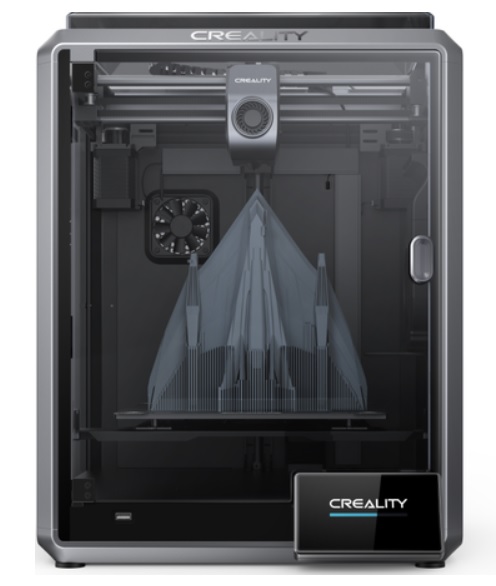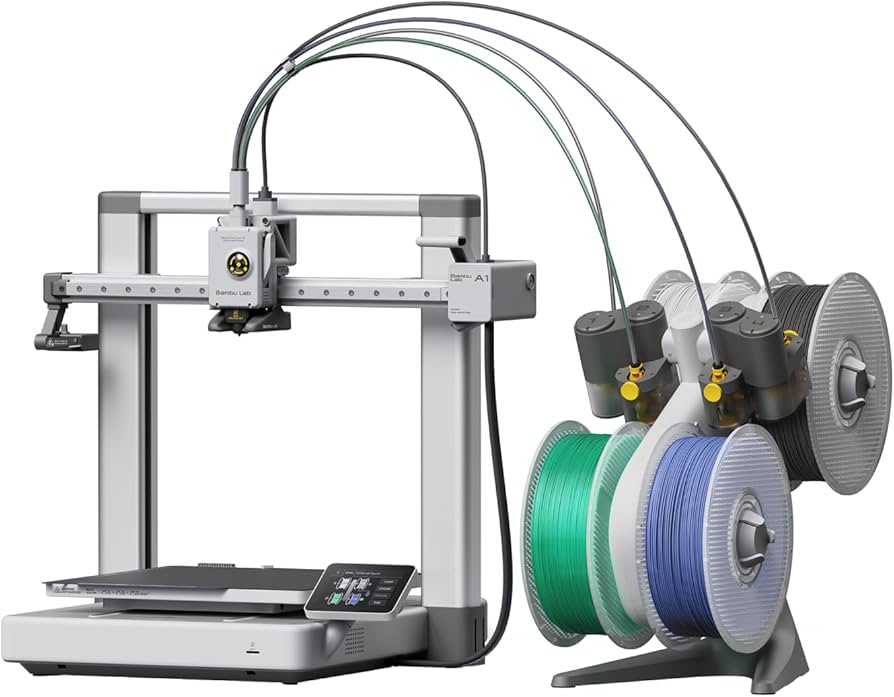Compare K1C vs A1
Comparison between the best 3D printers
Choose the best 3D printer at the best price. The cheapest 3D printers are here.
Buy a 3D printer here with 3D Fila.
 |
 |
|
| Model | K1C[BUY K1C] |
A1[BUY A1] |
| Printing Material | Filament | Filament |
| Buy Filament for Creality 3D K1C | Buy Filament forBambu Lab A1 | |
| Estimated price | $449,00 | $700,00 |
| Manufacturer | Creality 3D | Bambu Lab |
| Release Year | 2024 | 2023 |
| Print Volume [mm] | 220x220x250 | 256x256x256 |
| Printer Size [mm] | 355x355x480 | 385x410x430 |
| Weight [kg] | 12,4 | 8,3 |
| Power Loss Recovery | YES | YES |
| Enclosed printer | YES | NO |
| Bed Leveling | Automatic | Automatic |
| Filament End Sensor | YES | YES |
| Bed type | Heated | Heated |
| Power supply system | Direct Drive | Direct Drive |
| Standard nozzle | 0,4 | 0,4 |
| Maximum Nozzle Temperature [°C] | 300 | 300 |
| Maximum Bed Temperature [°C] | 120 | 100 |
| Maximum printing speed [mm/s] | 600 | 500 |
| Filament holder | YES | YES |
| Camera for supervision | YES | YES |
| Recommended filaments | ABS, PLA, PETG, PET, TPU, PA, ABS, ASA, PC, PLA-CF, PA-CF, PET-CF | PLA, PETG, TPU, PVA |
| Recommended slicers | Creality Print; Cura, Simplify3D e PrusaSlicer | SuperSlicer, PrusaSlicer, Cura, OrcaSlicer |
| Maximum Resolution [mm] | 0,1 | 0,1 |
| Processor | ||
| Display | Display touchscreen 4,3'' | Touchscreen 3,5 |
| Power Supply | 110/220V / 350W | 350 W |
| Connectivity | Ethernet / USB / Wi-Fi | Wi-Fi, Bambu-Bus, Cartão Micro SD |
| Operating systems | Windows, Mac, Linux | Windows, Linux, Macbook |
| Date of registration in the system | 2024-05-16 | 2024-07-17 |
| Release date | 2024 | 2023 |
| Extra features | The Creality K1C is a fully enclosed CoreXY 3D printer featuring an all-metal extruder, tri-metal Unicorn nozzle for abrasive materials, automatic bed leveling with nozzle cleaning, AI-assisted failure detection, built-in camera for timelapse, enhanced cooling system, root access to Klipper firmware, and compatibility with PLA-CF, PA-CF, PET-CF, TPU, ABS, and more. | The BambuLab A1 printer features fully automatic calibration, multi-color printing with the AMS system, active flow rate compensation, quick nozzle change with a clip, active motor noise cancellation, a build volume of 256x256x256 mm³, a maximum extruder temperature of 300°C, and a heated bed of up to 100°C. In addition, it has high precision, a machine health management system and an intuitive 3.5-inch touchscreen interface. |
| Support for multiple colors and materials (AMS and CFS) | NO | YES |
Notes * |
||
| Cost-benefit | 8 / 10 | 7 / 10 |
| Hardware | 5.4 / 10 | 4.8 / 10 |
| Tela | . | . |
| Print volume | 3 / 10 | 4 / 10 |
| Performance | 5 / 10 | 4 / 10 |
| [BUY K1C] | [BUY A1] |
Conclusion |
| In comparing the Creality 3D K1C and the Bambu Lab A1, several key differences highlight their strengths and weaknesses, particularly in terms of features, performance, and value for money. The K1C is positioned as a more economical option, boasting a fully enclosed design which offers advantages for temperature-sensitive materials and improved print reliability. Its larger print volume and higher maximum bed temperature enhance its capability for a wider range of projects. The inclusion of advanced features such as AI-assisted failure detection and enhanced cooling systems makes it a strong candidate for enthusiasts and professionals alike. Additionally, its compatibility with a diverse array of filaments expands its versatility. However, its heavier weight may be a consideration for users requiring portability. On the other hand, the Bambu Lab A1, while more expensive, offers impressive features geared towards ease of use and high precision, such as multi-color printing with the AMS system and an intuitive interface. Although it has a slightly smaller print volume and lower maximum bed temperature compared to the K1C, it compensates with its active flow rate compensation and machine health management system, which can contribute to hassle-free operation. In terms of value, the K1C scores higher, offering a better cost-to-benefit ratio and more robust hardware specifications for the price. The A1, however, appeals to users who prioritize advanced features and user-friendliness in their printing experience. Ultimately, your choice between the K1C and A1 will depend on your specific needs: if budget and versatility are critical, the K1C is the better option; if high precision and advanced functionalities are your priority, then investing in the Bambu Lab A1 may be worthwhile. |

